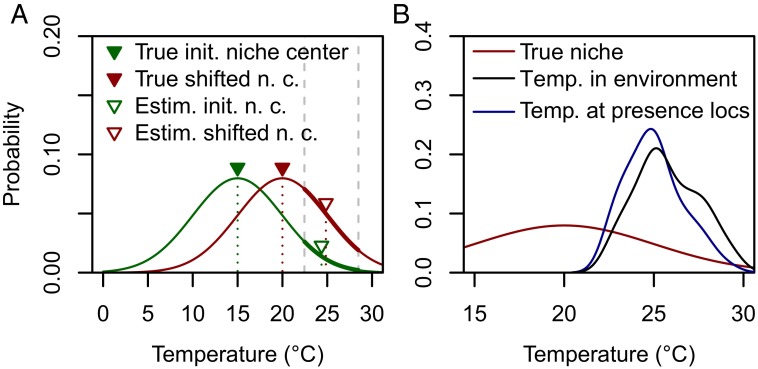Irwin et al. recently published a study that investigates the capacity of phytoplankton to adapt their ecological niches to changing environmental conditions (1). The authors find in a 15-y time series of field observations that phytoplankton taxa significantly change their ecological niches in line with environmental changes in irradiance, nitrate, and temperature. Irwin et al. conclude that this is evidence of evolutionary adaptation to a changing environment. Evolutionary adaptation summarizes heritable changes of physiological processes that improve the fitness of species under the novel environmental regime. In other words, it summarizes changes in their fundamental niches. Whereas, for plankton, the fundamental niche may be comparably well represented by its realized niche (2), it can only be described reliably by considering the entire spectrum of suitable conditions. However, the range of conditions in the Irwin et al. (1) study is rather narrow. Temperatures, for example, range from 22 to 28 °C.
We first examined available data on the thermal niches for the taxa in question, to see how well they are represented in the Irwin et al. (1) study. The taxa analyzed are known to be temperature generalists: of the 67 taxa used, 50 are reported on the Encyclopedia of Life,* and the majority exhibit broad thermal ranges (median range 29 °C). Similarly, a study (3) containing global estimates of 34 taxa in common with Irwin et al. (1) found the median niche width to be at least 10 °C. Irwin et al. investigated local populations that may have evolved narrower thermal niches. However, isolated phytoplankton strains also show wide thermal niches in the laboratory (median range of 25 strains: 30 °C) (4). Therefore, it seems likely that the majority of the investigated taxa have fundamental thermal niches much broader than the temperature range considered in the study (1).
We next assessed the impact of this problem through a simple simulation. We produced 100 pseudo-observations for the temperature data used in the study for 50 bell-shaped fundamental niches with sequentially increasing means from 10 to 23 °C and a SD of 4 °C. We then used the same method as Irwin et al. (1) to estimate shifts in the observed temperature niches. Only pseudo-observations produced by assuming a change in the fundamental thermal niche of 8 °C yielded shifts in estimated niche centers close to the reported change of 0.45 °C. The method used therefore appears to be unable to resolve the proposed changes: the strong bias of the estimates toward the center of the temperature range examined erodes the true differences between the fundamental niche centers (Fig. 1A). Moreover, the weak signals of broad temperature niches are hard to “see” for MaxEnt and can cause imprecise niche center estimates, especially if as few as 10 observations per species are used (Fig. 1B).
Fig. 1.
Weaknesses of the method applied by Irwin et al. (1). (A) Only considering the temperature range used in the study (dashed gray lines) will lead to biased estimates of shifts in thermal niches. The difference between initial niche center (green) and shifted niche center (red) will be estimated too narrowly. (B) The signal-to-noise ratio in the training data for MaxEnt is low. MaxEnt estimates are based on the difference between background temperatures (black) and temperatures at presence locations (blue), which are small for broad thermal niches (red). Because temperatures at presence locations were estimated, at least in part, based on few observations, niche center estimates may have a low precision.
We suggest instead that temperature is not a limiting factor for most species in the considered environment and that the changes they observed may be artifacts related to the abrupt shift in the entire pelagic community coincident with the start of the second measurement period, which reduced the abundances of many of the phytoplankton species by 50- to 300-fold (1).
Footnotes
The authors declare no conflict of interest.
References
- 1.Irwin AJ, Finkel ZV, Müller-Karger FE, Troccoli Ghinaglia L. Phytoplankton adapt to changing ocean environments. Proc Natl Acad Sci USA. 2015;112(18):5762–5766. doi: 10.1073/pnas.1414752112. [DOI] [PMC free article] [PubMed] [Google Scholar]
- 2.Helaouët P, Beaugrand G. Physiology, ecological niches and species distribution. Ecosystems (N Y) 2009;12(8):1235–1245. [Google Scholar]
- 3.Brun P, et al. Ecological niches of open ocean phytoplankton taxa. Limnol Oceanogr. 2015;60(3):1020–1038. [Google Scholar]
- 4.Boyd PW, et al. Marine phytoplankton temperature versus growth responses from polar to tropical waters—Outcome of a scientific community-wide study. PLoS One. 2013;8(5):e63091. doi: 10.1371/journal.pone.0063091. [DOI] [PMC free article] [PubMed] [Google Scholar]



